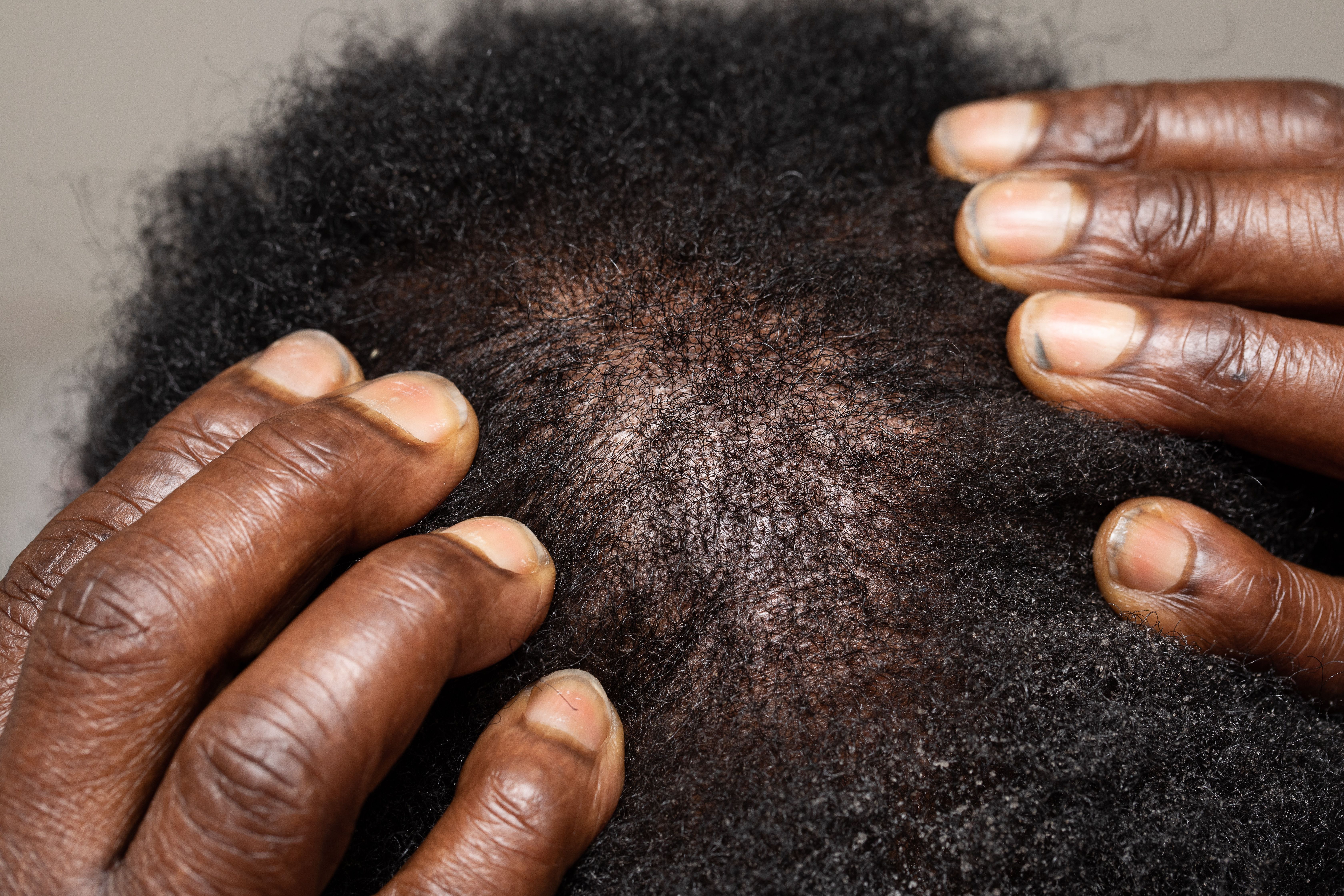- Center on Health Equity & Access
- Clinical
- Health Care Cost
- Health Care Delivery
- Insurance
- Policy
- Technology
- Value-Based Care
Insurance Coverage Limits JAKi Therapy Access for Patients With AA, Especially Non-White Populations
A survey study showed major barriers to Janus kinase inhibitor (JAKi) therapy for patients with alopecia areata, especially for non-White patients who face higher rates of being uninsured and struggle more to afford the treatment.
Thin hair loss on non-White man | Image Credit: Alessandro Grandini - stock.adobe.com

Patients with alopecia areata (AA) endure various challenges when attempting to obtain Janus kinase inhibitor (JAKi) therapy, and these challenges may exacerbate racial inequities in care access and quality, according to a new study.1
Researchers conducted a patient-centered survey to gather real-world data based on JAKi therapy and the barriers patients face when accessing proper care. The study, published in the International Journal of Women's Dermatology, is significant because AA does not have many FDA-approved treatment options.
The FDA approved the first oral JAKi, baricitinib, in June 2022, but only for adults with severe AA symptoms. Following this, ritlecitinib was approved as the first oral JAKi in children 12 and older in June 2023. Baricitinib and ritlecitinib, both approved in the US and Europe, shield hair follicles from immune cells and can prevent autoimmune attacks.2
However, access to medications can be limited by high medication costs and difficulties with insurance coverage. Non-White patient populations are often disproportionately affected compared with White patients due to lack of representation as well as influences on patient retention.3
A total of 784 adult patients and parents of patients under 18 with AA enrolled in the patient-centered survey, but only 600 patients completed the entirety (76.5%). The study population was mainly women (80.2%) and majority White (73.8%), with an average age of 43 years. Overall, 70.7% patients reported more than 50% scalp involvement.
Around 13.4% patients expressed desire to begin treatment but were unable to get insurance coverage, while 20.7% did not begin treatment based on cost concerns. Notably, more White patients reported attempting to obtain JAKi (P = .33), and patients with greater than 50% scalp involvement were more likely to report trying to obtain therapy (P = .0071).
There were 33 patients that took JAKi therapy prior to the survey, but 30.3% discontinued medication due to intolerable adverse effects, while 9.1% disclosed they were paying out of pocket for the medication but could no longer afford it. A little more than half of the patient population appeared to discontinue therapy for other reasons.
Insurance coverage was a defining factor within the survey results for patients looking to access JAKi therapy. Almost half (41.3%) of patients reported no insurance coverage, 33.1% claimed partial coverage, and only 25.6% had full coverage. Patients with AA prescribed JAKi off-label were less likely to have insurance coverage (P = .02).
Patient satisfaction with insurance coverage was measured among the study population. It appeared about 43% of patients felt their coverage was very inadequate, 11% felt it was inadequate, 12.8% were neutral, 12.8% felt it was adequate, and 20.3% felt it was very adequate. Overall, patients were more likely to report inadequate satisfaction if they had less than 50% scalp involvement (P = .002).
More than half of the patient population used a copay assistance card to access their medications (55.2%), with a larger number of White patients using the assistance card (P = .024, P = .005, respectively). Some populations reported foregoing meals, gas, vacation or travel, school supplies, and leisure activities so they could afford therapy (12.2%). Furthermore, 19.8% patients said they had used their financial savings to pay for treatment, with those receiving therapy off-label more likely to use their savings (P = .011).
"Research has shown that systemic racial and socioeconomic inequalities impact access to dermatologic care, and limited medication insurance coverage may exacerbate these inequities," the authors wrote. "Our findings demonstrated that while significantly more non-White patients considered obtaining JAKi therapy, significantly more White patients tried to obtain the medication and endorsed currently or previously taking JAKi. These differences may reflect the impact of demographics on medication access."
The study was limited by the subjectiveness characteristic of survey studies, as well as the recency of FDA approvals for JAKi therapy, which may influence patients’ perceptions of access to care.
"As treatment options for patients with AA continue to expand, we hope that this information highlights the barriers this community faces when accessing care," the authors concluded. "Growing advocacy efforts for broader coverage for treatment and camouflaging agents to alleviate the burden that patients face is essential for ensuring appropriate care for this community."
References
1. Nohria A, Zhang C, Desai D, et al. Real-world experience quantifying access to JAK inhibitor care for alopecia areata patients: a patient-centered survey study. Int J Womens Dermatol. 10(2):p e145, June 2024. doi: 10.1097/JW9.0000000000000145
2. Santoro C. Targeting t-cell–based therapies to treat alopecia areata. The American Journal of Managed Care®. Published February 14, 2024. Accessed April 23, 2024. https://www.ajmc.com/view/targeting-t-cell-based-therapies-to-treat-alopecia-areata
3. Santoro C. Disparities in clinical trial enrollment, retention among marginalized racial and ethnic groups with AA. The American Journal of Managed Care®. Published January 13, 2024. Accessed April 23, 2024. https://www.ajmc.com/view/disparities-in-clinical-trial-enrollment-retention-among-marginalized-racial-and-ethnic-groups-with-aa
The Breakdown: Breast Cancer Research Awareness Day
August 19th 2025Breast cancer is the second most common cancer among women and the second leading cause of cancer-related deaths among women in the US. In light of Breast Cancer Research Awareness Day, The American Journal of Managed Care® breaks down the most recent advancements in breast cancer prevention, screening, and therapies.
Listen
